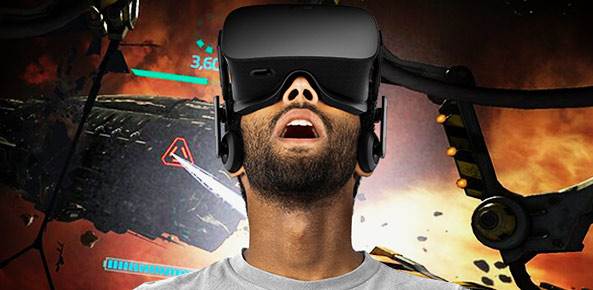The long-awaited Oculus Rift virtual reality system is now available for pre-ordering and is due to start shipping to customers on March 28. In its announcement today, Oculus also revealed the system’s price for the first time: $ 599.
Purchased by Facebook for $ 2 billion in 2014, Oculus has been developing both the Rift and another virtual-reality device, the Gear VR, which works with several kinds of Samsung smartphones. The consumer version of the Gear VR, a headset priced at $ 99, was released in late November.
By contrast, the higher-price Oculus Rift system includes a headset with built-in headphones as well as a microphone, a sensor, an Oculus Remote and an Xbox One controller. Pre-ordered systems will also ship with a game called Lucky’s Tale and include access to made-for-VR content through the EVE: Valkyrie through the Founder’s Pack.
Oculus-Ready PC Bundle Coming Soon
Available for pre-ordering through Oculus.com, the Rift is initially set to ship to 20 countries, including the U.S., U.K., Canada, Germany, Japan and Australia.
The company is also offering a $ 1499 bundle option that includes an Oculus Ready PC in addition to the VR system. Pre-ordering for the bundled system will start in February, but customers who order the Rift system now will qualify for the bundle price when the PC becomes available.
To get the full user experience for Rift, a customer will need a PC with at least 8 GB of RAM running 64-bit Windows 7 SP1 or higher. Each user will also need a graphics card equivalent to or greater than a Nvidia GTX 970/AMD R9 290, a processor equivalent to an Intel i5-4590 or higher, support for HDMI 1.3 video output and three USB 3.0 ports plus one USB 2.0 port.
Pre-ordering the Rift will also give customers a place in line for advance orders of the Oculus Touch gesture-based controllers. Set to ship in the second half of 2016, Touch “will unlock entirely new interactions” for VR users, Oculus said today in a blog post.
VR ‘Ready for Prime Time’
“I think the $ 599 price point was higher than some people expected, but it’s really not the key inhibitor for adoption — it’s having a PC that’s Oculus-ready,” J.P. Gownder, a Forrester Research Inc. analyst, told us. “Aside from gamers — and not even all of them — very few people have PCs with the specifications (high-end GPU, for example) needed. So most people would have to buy the Rift ‘and’ a $ 1k+ PC to use the device.”
While gamers will likely dominate the early-adopter market for the Oculus Rift, VR also “holds incredible promise for enterprise applications,” Gownder said. Medical training, travel marketing, construction and design are other areas where virtual reality promises great potential, and a number of organizations have already been experimenting with such technologies, he said.
Marriott, for example, has been using the Oculus Rift to showcase overseas hotels, while Microsoft has been working with organizations like Volvo, NASA and Case Western Reserve University in tests of its holographic, augmented computing system HoloLens.
A developer version of the HoloLens — priced at $ 3,000 — is expected to become available in the first quarter of this year, according to Microsoft.
Another area where virtual reality could have a dramatic impact is in online shopping, Gownder said.
“VR holds the promise of changing e-commerce significantly,” Gownder noted. “When we shop online, we’re using abstractions (menus and hierarchies) that are very different from actually walking down the aisle of a store. But VR can reproduce brick-and-mortar shopping experiences realistically, then superimpose digital information on top.”
In a report on VR and AR (augmented reality) released in July, Gownder said that such technologies are “finally ready for prime time.”






